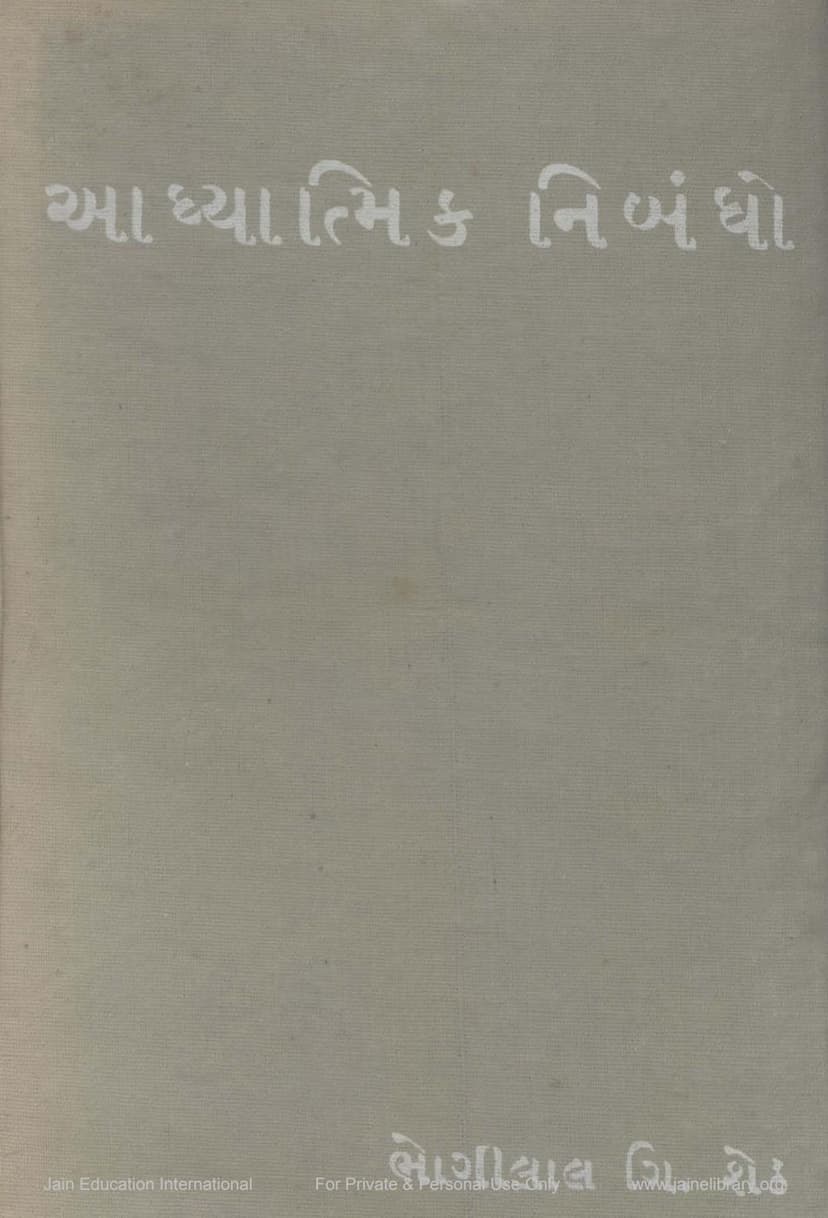Adhyatmik Nibandho
Added to library: September 1, 2025

Summary
This document is a summary of the book "Adhyatmik Nibandho" (Spiritual Essays) authored by Bhogilal G. Sheth, published by Shreyas Pracharak Sabha. The book contains seven spiritual essays exploring various aspects of Jain philosophy and spiritual practice.
Here's a summary of the key themes and essays presented in the book:
Overall Theme: The book focuses on spiritual upliftment, understanding the true nature of the soul, and the path to liberation (moksha) according to Jain principles. It emphasizes the importance of right faith (Samyak Darshan), right knowledge (Samyak Gyan), and right conduct (Samyak Charitra).
Essays and their Core Ideas:
-
"Satsang no Mangal Updesh no Saar" (Essence of the Auspicious Teachings of the Virtuous): This essay highlights the transient and suffering-filled nature of the material world and emphasizes that only Dharma (righteousness) and the soul are eternal and offer true refuge and fearlessness. It draws upon the teachings of great souls (Sapurush) who emphasize that the soul, through diligent effort and detachment from worldly desires, can attain a state of pure consciousness and bliss. The essay also delves into the nature of karma, differentiating between those that obscure the soul's qualities (ghati) and those that do not (aghati), and the path to their destruction.
-
"Jem Mati madhi Ghadon thay, tem Jeev madhi Shiv thay" (Just as a Pot is Made from Clay, So the Soul Becomes the Pure Soul): This essay uses the analogy of pottery making to illustrate the process of spiritual transformation. It explains that just as specific qualities are needed in clay for a pot to be formed, certain essential qualities in the soul (like detachment, equanimity, and wisdom) are necessary for liberation. It also touches upon the crucial role of both the material cause (upadan karan) and the instrumental cause (nimitta karan) in achieving any goal, emphasizing the importance of a true spiritual guide (Sadguru) in the soul's journey towards liberation.
-
"Pushpa upar ek Vichar" (A Thought on the Flower): This essay reflects on a beautiful, solitary flower as a metaphor for the soul. The flower's natural beauty, its constant blooming, and its attraction towards those who appreciate it are compared to the soul's inherent purity and its subtle ways of attracting a true seeker. The essay suggests that the flower symbolizes "Samyak Darshan" (Right Faith), which is the foundational step for the soul's journey towards becoming pure (Shiva). It discusses the profound significance of Samyak Darshan in drawing a seeker towards the path of spiritual realization.
-
"Jatismaran Gyan" (Knowledge of Past Lives): This essay discusses the Jain concept of "Jatismaran Gyan," the ability to recall past lives. It explains how this knowledge, when attained after the age of seven and verified, can lead to the attainment of Samyak Darshan and ultimately liberation within a limited number of future lives. The essay explores the various reasons why this knowledge is not always retained, attributing it to factors like attachment to the physical body, ignorance, and the influence of karma. It also details the conditions and spiritual practices that can help in recalling past lives.
-
"Runanubandh" (Karmic Connections): This essay delves into the concept of "Runanubandh," the karmic bonds formed through past actions and the resulting relationships in this life. It explains how desires, attachments, and aversions create these connections, which manifest as familial ties, friendships, and even enmities. The essay elaborates on how these karmic debts are settled through interactions in life, and how new karmic bonds are formed. It emphasizes that true liberation occurs only when all karmic accounts are settled, and that while worldly relationships are temporary, those forged through spiritual devotion can aid in spiritual progress. The essay illustrates this with examples of both positive (Shubh) and negative (Ashubh) Runanubandh in action, including relationships with divine beings and the impact of karma across lifetimes.
-
"Atmanubhuti" (Self-Realization): This essay focuses on the experience of the soul's true nature. It defines the soul as inherently pure, conscious, and blissful, existing independently of the physical body and external circumstances. The essay highlights the various paths to self-realization, including knowledge, meditation, action, and devotion, and posits devotion (Bhakti) as the most accessible path for the spiritually uninitiated. It emphasizes that true self-realization cannot be attained through mere intellectual understanding or ascetic practices but through intense focus and devotion towards a true spiritual guide.
-
"Prem ane Purnata" (Love and Wholeness): This essay explores the profound nature of love as the ultimate key to achieving spiritual perfection and self-realization. It defines love as an intrinsic quality of the soul, which, when cultivated, leads to a state of unwavering devotion, peace, and ultimate union with the divine. The essay discusses the various stages of love, from its initial blossoming to its ultimate fulfillment, and how it transcends worldly attachments and desires. It highlights the transformative power of love, its ability to purify the soul, and its role in overcoming obstacles on the spiritual path, drawing parallels from various spiritual traditions.
Overall Message: The book "Adhyatmik Nibandho" serves as a guide for spiritual seekers, offering profound insights into the Jain path of liberation. It encourages introspection, self-awareness, and the cultivation of virtues like love, faith, and devotion as essential steps towards realizing the soul's true, eternal nature. The essays are rich in philosophical depth and practical guidance, aimed at fostering spiritual growth and well-being.